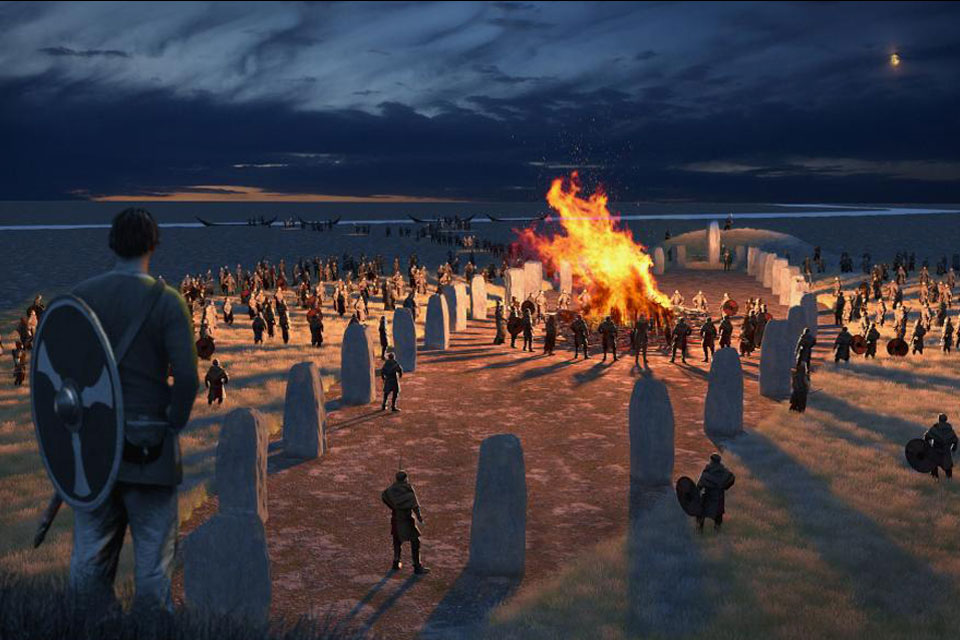Archaeologists recently discovered a huge ship-setting from c. AD 600 near the largest river in Northern Denmark near Vejerslev.
Known from old records, archaeologists had long suspected that the place-name “Høj Stene” indicated an important archaeological site. Although the setting had been demolished and at some point removed in the early 19th century, the exact location was recently re-discovered by archaeologists from Moesgaard.
At the site they found what turned out to be the second-largest ship-setting in Northern Europe, measuring nearly 90 metres and still holding the remains of the funeral pyre in the centre. In itself, this is a sensational find as archaeologist have long debated whether ship-settings were intended to mark out graves, or whether they were just monuments, thingsteads, or astronomical observatories erected in the countryside. The new ship-setting with the cremation in its centre solves this question. The ship-settings, it appears, were foremost intended as burial monuments.
Excavations of the grave further revealed remarkable finds of 21 gold-pieces in more or less melted condition as well as 50 pieces of bronze. Studies of the site and the finds indicate a date around AD 600, placing it at the centre of what in a Danish context is known as the Late Germanic Iron Age (AD 550 – 750). In a Swedish context, this corresponds to the Vendel Period. In a continental European context, the period is known as the Merovingian.
“An elaborately ornamented piece of gold foil points unequivocally towards a date in the early part of the Late Germanic Iron Age,” explains archaeologist Mogens Høegsberg of Moesgaard Museum, who is directing the excavations.
“The size of the monument makes it the clearest indication of the presence of an elite in Jutland, and the most striking burial monument in Denmark during that period. This is the same time that a new powerful elite and monarchy appear in Scandinavia, with the major royal residences at Lejre in Denmark and in Uppsala in Sweden, and in England, with the rich royal ship burial at Sutton Hoo,” says Mads Kähler Holst, director of Moesgaard Museum.
The significant characteristic of these three sites – Sutton Hoo, Lejre, and Uppsala – is the stylistic affinity of the material culture excavated on these sites. Lejre, however, stands apart as it also revealed a series of impressive mead halls in the nearby settlement. Preliminary investigations in the countryside near Stor Høje indicate that the remains of a nearby settlement and hall may have been found, promising a similar context to the ship-setting as that which has been excavated at Lejre.
“Magnates operating in these different parts of Northern Europe appear to have had close links across this large area. They used the same symbols and had almost identical rich animal-style ornamentation on their artefacts. The ship was central to their burials, either in the form of actual ship burials or stone ship settings”, we are told.
Hygelac
In the presentation of the find, the archaeologists have preferred to talk about “magnates”. In an international context, however, the idea that there lived “kings” in Denmark at this time, was widespread. One particular king, Hygelac or Ch(l)ochilaicus is of special importance as he ended up in the chronicle of Gregory of Tours, the 8th-century Liber Historiae Francorum, the 8th-century work from England, Liber Monstrorum, as well as Beowulf. According to these sources, we learn that Ch(l)ochilaicus (Huiglaucus or Hygelac) made a piratical raid upon Frisia between the lower Rhine and the Zuyder Zee. After plundering the village, the king remained on the shore where he was caught and slain. In the French Chronicles, Hygelac was said to be “King of the Danes” while he is known in the English sources as “king of the Geats”. It is likely that both epithets were just general indications of “a people to the northwest” and there is absolutely no reason to believe that the newly found grave can be directly linked up to this spurious king.
What the sources from the 6th and the 7th centuries do tell us is, though, is that at this time stories were circulating about magnates from Scandinavia with the power to mount piratical raids on the foreshores of Frisia. The newly found shipsetting with its date at the end of the 6th century and beginning of the 7th does contribute to the cultural history of these proto-kings.
SOURCE:
One of Northern Europe’s Largest prehistorical Burial Monuments discovered in Denmark.
READ MORE:
Monumentale skibssætninger i Danmark og Skåne
By Felix Vestergaard
In: Kuml (2007), Vol 56
FEATURED PHOTO:
Reconstruction of burial and cremation at the ship-setting at Gudenaaen in the 7th-century © Moesgaard/Eric Sosa
